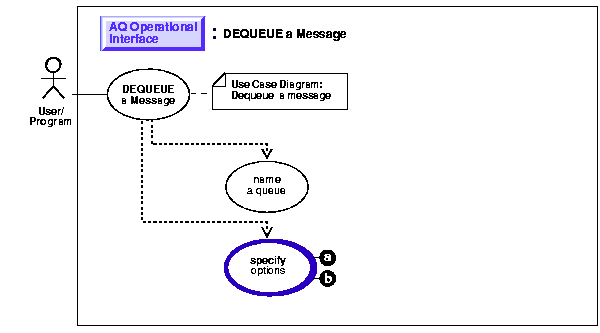Release 2 (8.1.6)
Part Number A76938-01
Library |
Product |
Contents |
Index |
| Oracle8i Application Developer's Guide - Advanced Queuing Release 2 (8.1.6) Part Number A76938-01 |
|
Operational Interface: Basic Operations, 11 of 16

Dequeues a message from the specified queue.
READY state are dequeued unless a msgid is specified.
BROWSE call may not see a message that is enqueued after the beginning of the browsing transaction.
The default NAVIGATION parameter during dequeue is NEXT MESSAGE. This means that subsequent dequeues will retrieve the messages from the queue based on the snapshot obtained in the first dequeue. In particular, a message that is enqueued after the first dequeue command will be processed only after processing all the remaining messages in the queue. This is usually sufficient when all the messages have already been enqueued into the queue, or when the queue does not have a priority-based ordering. However, applications must use the FIRST MESSAGE navigation option when the first message in the queue needs to be processed by every dequeue command. This usually becomes necessary when a higher priority message arrives in the queue while messages already-enqueued are being processed.
LOCKED or REMOVE mode locks only a single message. By contrast, a dequeue operation that seeks to dequeue a message that is part of a group will lock the entire group. This is useful when all the messages in a group need to be processed as an atomic unit.
NEXT TRANSACTION to start dequeuing messages from the next available group. In the event that no groups are available, the dequeue will time-out after the specified WAIT period.
See Chapter 3, "AQ Programmatic Environments" for a list of available functions in each programmatic environment. Use the following syntax references for each programmatic environment:
See Chapter 3, "AQ Programmatic Environments" for a list of available functions in each programmatic environment. Examples in the following programmatic environments are provided:
|
|
 Copyright © 1996-2000, Oracle Corporation. All Rights Reserved. |
|